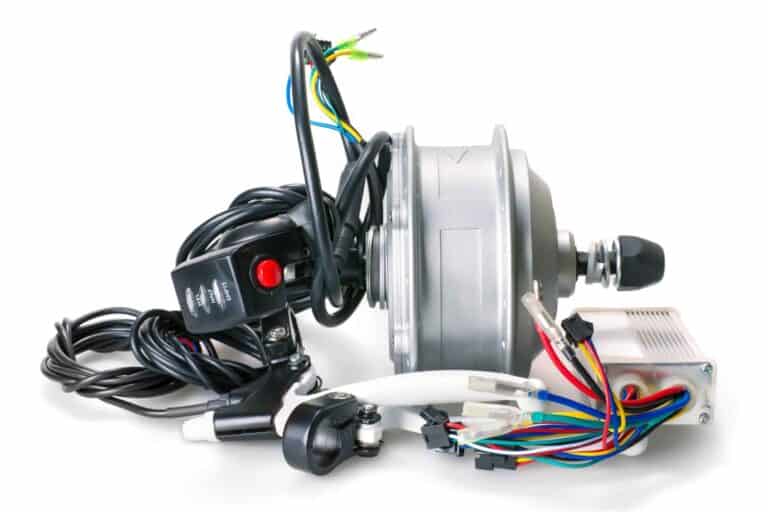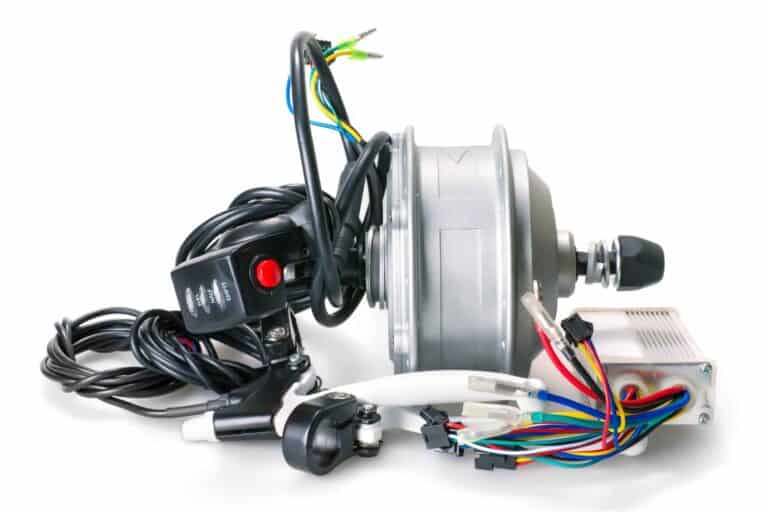Charging eBike Battery the Right Way (First Time & Everytime)
Electric bikes come with batteries that require charging. Many individuals often wonder how often they should charge their electric bike battery, for the first time and for regular charging.
As a general rule, electric bikes have different charging times depending on the model. Newly bought electric bikes should be charged for about 12 hours the first time and can be fully charged in about 3.5-6 hours for each subsequent charge.
When our e-bike battery is depleted, we always make sure to charge it properly so we can enjoy riding our e-bike. In this article, we will delve into the charging times of various electric bikes and provide some helpful tips for charging e-bike batteries, as well as answer questions related to charging e-bike batteries.
How Long Do You Charge eBike Battery for the First Time?
As a whole, when you have a new electric bike or new electric bike batteries, it’s advisable to charge them for about 12 hours. This ensures that the e-bike battery is properly conditioned and that there is a consistent flow of energy within the battery.
The long initial charge ensures that your electric bike will deliver optimal performance during your rides. After this initial charge, you can follow a specific charging time, typically provided in your electric bike’s specifications. Most e-bikes can be fully charged in about 3.5-6 hours, though some may have shorter or longer charging times, ranging from under 3.5 to over 6 hours.
It’s advisable to charge your electric bike to 80-85% for regular use to maintain its maximum performance over time. A complete discharge and charge cycle should be performed only occasionally. Charging your electric bike to 100% is recommended when planning a long ride.
How Long Does eBike Battery Take to Charge?
As a general rule, electric bike batteries typically take about 3.5 to 6 hours to reach a full charge. The charging time for each e-bike model varies based on the capacity of the e-bike battery. Some may require less than 3.5 hours, while others may need more than 6 hours to charge completely.
Electric bike batteries from different models have varying charging times, which depend on their capacities and the type of charger used. In most cases, electric bike batteries with higher capacities will take longer to reach a full charge. The charger used can also be a factor, as some chargers are explicitly designed for fast charging.
If you’d like to determine the approximate charging time for your electric bike, you can consult your e-bike’s specifications. If the charging time is not listed, you can contact the seller and request this information. Another method to estimate the charging time is by timing how long it takes for your e-bike to charge, which will help you plan for future charges.
How Long to Charge 48v eBike Battery
As a whole, the charging time of a 48V e-bike battery depends on the e-bike model. The charging time for an e-battery typically falls within the range of about 3.5 to 6 hours. It is important to note that some electric bike models may have charging times shorter or longer than this approximate range.
The charging time of any electric bike does not solely depend on the e-bike’s voltage. Whether you have a 24V, 36V, 48V, 52V, or 72V battery, the charging duration is determined by the battery’s capacity and the charging current. Some electric bike manufacturers provide fast-charging chargers, while others do not. As a result, some riders choose to use fast-charging chargers to reduce the time required for a full battery charge. However, it’s important to emphasize that using the recommended charger from the manufacturer is always the safest option to prevent potential damage to your e-bike battery.
Electric Bike Charging Time
As a whole, the charging time varies between different electric bike models. While the majority of them can be fully charged in about 3.5 to 6 hours, there are electric bikes with faster charging times, less than 3.5 hours, as well as models that might take as long as 10 hours to charge completely.
Here is a list of electric bikes, along with their specified charging times, as listed in their specifications.
| Electric Bikes | Cost | Battery Capacity | Range | Charging Time |
| Ghost Electric Mountain Bike | $1,249 | 720Wh | 23+ miles (37+ km) on throttle40+ miles (64.4+ km) on pedal assist | 80% in 4 hours and fully charged in 8 hours |
| XP 3.0 Black eBike (Standard Battery) | $999 | 500Wh | 45 miles (72.4 km) | 4-6 hours |
| RadRunner Plus | $1,999 | 672Wh | 25-45+ miles (40.2-72.4+ km) | 3-7 hours |
| Aveny Skyline | $1,699 | 614Wh | 45 miles (72.4 km) | 4-5 hours |
| Velotric Go 1 | $1,299 | 691.2Wh | 55 miles (88.5 km) | 0-80%-4 hours0-100%-6 hours |
| Freedom 2 | $948.98 | 316.8Wh | 35 miles (56.3 km) | 4 hours |
| 700 SERIES | $1,295 | 864Wh | 30-50 miles (48.3-80.5 km) | 3-6 hours |
| CITYTRI E-310 PLUS | $2,099 | 960Wh | 90+ miles (144.8 km) | 9-10 Hours |
| Priority Current E-bike | $ 3,299 | 500Wh | 20-50 miles (32.2-80.5 km) | 0% to 100%- 2 to 3 hours |
| Aventure 2 E-bike | $1799 | 720Wh | 60 miles (96.6 km) | 4-5 hours |
Should I Charge My eBike After Every Ride?
As a general rule, you can charge your electric bike after every ride, depending on several factors, including the battery’s capacity, the distance you traveled on your previous ride, and how often you ride your electric bike.
Before deciding whether to charge your e-bike battery after every ride, consider your battery’s capacity. If you have a lower-capacity battery, it’s a good practice to charge it after each ride. However, if you possess a high-capacity battery and your rides cover shorter distances, charging after every ride may not be necessary, especially if your battery still has sufficient charge for the next trip.
Nonetheless, it’s crucial to avoid regularly discharging your electric bike battery fully, as this can significantly impact its lifespan. Instead, we recommend charging your e-bike when the battery percentage falls within the range of 20-40% and charging it up to 80-85%. This approach helps maintain your battery’s peak performance over an extended period.
How Many Times Can You Charge an eBike Battery?
As a whole, you can charge your electric bike battery as often as necessary, provided that it reaches a certain percentage that indicates it needs charging. Typically, it’s recommended to charge electric bike batteries when their charge level falls within the range of 20-40%.
The frequency of charging your electric bike battery primarily depends on your preferences and how frequently you ride your electric bike. If you want your electric bike to maintain its best performance and efficiency for an extended period, we highly recommend charging the electric bike battery only when the percentage reaches 20-40%. Charging your electric bike battery with a high percentage can negatively affect your battery’s performance, efficiency, and lifespan.
Your riding habits can be a factor in determining how often you should charge your electric bike. So, it would be best to assess how far you plan to travel. If you are someone who seeks to cover longer distances and needs the maximum range available, riding your e-bike with a 100% charge would be ideal. However, if your daily rides are shorter, charging your battery to 80-85% would be recommended.
Additionally, it is advisable to occasionally fully discharge your electric bike battery and charge it up to 100%. This ensures that your battery will maintain maximum performance in the long run.
“Take your time. Recharge and come back stronger.”-unknown
How Do I Know When My eBike Battery is Charged?
As a general rule, there are several ways to determine if your e-bike battery is already charged. Some e-bikes have LED indicators that change color when they’re fully charged, and some e-bike manufacturers allow e-bikes to be connected to an app, enabling you to check the battery level of your e-bike.
Most electric bike battery chargers come equipped with LED indicators. Typically, when you plug in an e-bike battery, the LED turns red, and it changes to green when the battery is fully charged. If you charge your e-bike battery without removing it from your e-bike, you can check the battery percentage or level on your electric bike’s LCD screen. Moreover, some electric bikes can be connected to a smartphone app, allowing you to monitor your e-bike’s battery level from your phone.
It’s crucial to use the charger recommended by the e-bike’s manufacturer. In most cases, chargers are included in the package, so you don’t need to search for a suitable one. Also, be mindful of the charging time for your electric bike. Setting an alarm can help you remember to unplug your e-bike battery and avoid overcharging.
Should eBike Battery Be On or Off When Charging?
As a whole, when deciding whether e-bike batteries should be on or off when charging, the primary decision depends on the e-bike’s manufacturer. Manufacturers always provide a manual on how to charge your electric bike battery.
In most cases, it is advisable to turn off your e-bike battery when charging to prevent overheating. However, some manufacturers may suggest leaving the battery on. Therefore, it’s always a good idea to consult your e-bike’s manual to understand the correct procedure for handling and charging your electric bike battery. Manufacturers possess the best knowledge on ensuring your battery stays in good condition and maintains optimal performance.
Can You Overcharge eBike Battery?
As a whole, it is highly advisable not to overcharge your electric bike battery. Overcharging can lead to overheating and potential damage to your battery, significantly impacting its performance or, in the worst-case scenario, causing a short circuit and potentially starting a fire.
Some electric bike manufacturers have equipped their e-bikes with batteries or chargers that automatically shut off when the battery is fully charged. This feature helps prevent overcharging. However, it’s important to note that not all electric bikes have this system. Therefore, it’s generally a wise practice to unplug your electric bike once it has reached a charge level of 80% to 100%. This precautionary measure is a simple yet effective way to avoid overcharging and maintain your battery’s performance and safety.
If you’re interested in learning more about how to maintain your electric bike’s lithium-ion batteries, you can watch the video below.
How to Charge eBbike Battery Without Charger?
As a whole, charging an electric bike battery without a charger can be risky, but it is still possible using alternative methods such as:
- Using a USB charger
- Using a universal charger
- Charging at e-bike charging stations
- Using a car charger
Charging eBike Battery Using a USB Charger
While this may be feasible for some electric bikes, it’s essential to understand that not all electric bike batteries have available USB charging ports. It’s worth noting that USB cables are commonly used to charge devices with a power bank, which may have a lesser capacity and might not be capable of fully charging your electric bike, potentially resulting in longer charging times.
Use a Universal Charger to Charge an eBike Battery
When charging an eBike battery, it is crucial to use a suitable charger. If the original charger for your e-bike battery is no longer functional, consider using a universal charger as an alternative. However, it’s crucial to remember that each e-bike battery has a different voltage. If your universal charger is incompatible with the voltage of your e-bike’s battery, there’s a high probability that it won’t work or could potentially damage your e-bike battery. Therefore, it is always recommended to consult your e-bike’s manual to determine the compatible charger for your specific e-bike battery. You can also check with the store where you purchased your e-bike to see if they have suitable replacement e-bike batteries available.
Charging eBike Battery Without a Charger at eBike Charging Stations
As electric bikes gain popularity, numerous charging stations have been built, both indoors and outdoors. Charging an electric bike battery without a charger is more convenient when utilizing these charging stations. Depending on the specific station, e-bikes can be charged with the battery connected or by charging the battery separately. So, if you don’t have a charger, you can locate the nearest charging station in your area and plug your electric bike battery into it using a compatible charging cable or port.
While there are many charging stations available, it’s possible that none may be in your area. Additionally, charging eBikes at these stations may involve fees, so it’s advisable to have cash or a card on hand.
Charging eBike Battery Using a Car Charger
When you don’t have a charger available for your electric bike, you can choose to use a car charger if you have a car with a cigarette lighter socket. You will need to find a car charger compatible with your e-bike battery and plug it into your car’s power source. However, when using this alternative method, remember that the current supply from a car’s power source is greater. It’s an excellent practice to regulate the current flow by connecting light bulbs, which will prevent a direct current to your e-bike’s battery and help prevent long-term damage to your e-bike’s battery.
While it’s always recommended to use a compatible charger for your e-bike battery, there may come a time when your charger stops working, and you need more money for a replacement. In such cases, people may resort to the alternatives mentioned above or other methods that were not listed. However, it’s crucial to know the potential risks involved when charging your e-bike battery without the appropriate charger.
How Do You Break in a New eBike Battery?
As a whole, the primary thing to do to break in your electric bike battery is to allow a long initial charge of about 12 hours. While this may be enough for some, some riders opt to have their e-bike batteries undergo three consecutive full discharge and charge cycles when breaking in.
For some riders, they prefer to charge their electric bike for about 12 hours right after it has been delivered. After the 12-hour initial charge, they use the e-bike until it reaches 20-40% battery capacity and then charge it back up to 80-85%. They continue this pattern and only perform a full discharge and charge occasionally.
However, some riders choose to go through a series of three consecutive full-discharge and charge cycles to break in the new e-bike battery. After this, they use the e-bike until it reaches 20-40% capacity and then charge it back up to 80-85%. They continue this pattern and perform a full discharge and charge once in a while.
When breaking in your new e-bike battery, it is always best to follow the manufacturer’s recommendations. If you are unsure what to do, you can contact them through various means, such as calling, emailing, or visiting the store in person if you are nearby.

eBike Battery Charging Tips
As a general rule, it is always recommended to follow your e-bike manufacturer’s charging guidelines to ensure your electric bike battery provides optimal performance, improves its lifespan, and keeps you safe.
Here are some helpful tips for charging your e-bike battery:
- Always use a suitable charger for your electric bike battery. Most new electric bikes have a charger, so you don’t need to search for a compatible one. If your e-bike is a few years old and the charger is no longer working, it’s best to contact the manufacturer to inquire about a replacement. If no replacement is available, you can ask them for a recommended charger for your e-bike model.
- When charging, it is crucial to keep your e-bike battery away from metal objects since metals are excellent conductors of electricity. Charging your electric bike battery near metallic objects can result in a short circuit, which may lead to a fire.
- It’s essential to keep e-bike batteries away from flammable materials to prevent potential fire or explosions during charging.
- When charging, always place your electric bike or e-bike battery on a clean and dry surface. Placing your battery on a wet surface can lead to short circuits and other electrical issues.
- Do not overcharge your e-bike battery. Overcharging can lead to overheating, which may result in fires, explosions, or other electrical issues.
- Always charge your electric bike within the recommended temperature range, avoiding extremely cold or hot conditions. To determine the acceptable charging temperature for your e-bike battery, refer to your e-bike’s manual.
When riding an electric bike, we always want to maximize our range and have the best riding experience. Sometimes, we opt to charge our electric bikes on the go. If you want insights on how to do this, read our article titled ‘Charging eBike on the Go (Car Battery, Inverter, Power Bank, Solar).’






